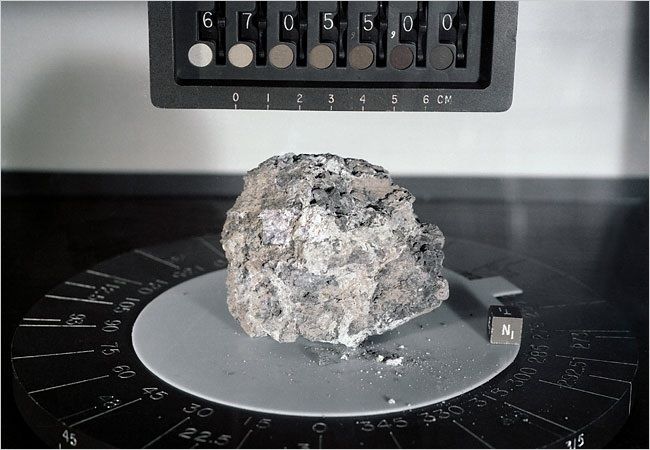|
Author
|
Topic: Apollo moon rocks: Measurement, marking tools
|
TLIGuy
Member Posts: 205
From: Virginia
Registered: Jul 2013
|
 posted 04-04-2014 05:46 AM
posted 04-04-2014 05:46 AM
   
Anyone here willing to school me on what all the components are in this image of a moon rock? I'm not so much interested in the rock at this time as I am the display and it's parts. I see three main things. - Rock sits on a round circle that appears to have a compass rose. Is the rock placed in a certain position to signify the position found on the surface of the moon or make finding a point of interest on the rock easier to find and make notes about surface features?
- Above the rock are numbers that can be flipped through. What are they showing? Along the bottom I see a scale marked cm. I assume this is the measurement?
- Lastly, what is the little block to the right? I see them in numerous pictures with different letters on each side.
 |
spaced out
Member Posts: 3110
From: Paris, France
Registered: Aug 2003
|
 posted 04-04-2014 06:16 AM
posted 04-04-2014 06:16 AM
   
I can answer no. 3 - that's a scale cube, commonly used with meteorites.Each side of the cube measures exactly 1cm. The faces are marked "T" for top, N/E/S/W for the side faces and "B" for bottom, and can be aligned to show the alignment of the meteorite when it is photographed in situ. I would assume the sample is also positioned on compass rose in the photo according to how it was found on the lunar surface. I believe the numbers in the background are the unique id of the sample, but I could be wrong. |
TLIGuy
Member Posts: 205
From: Virginia
Registered: Jul 2013
|
 posted 04-04-2014 06:52 AM
posted 04-04-2014 06:52 AM
   
Okay, that makes total sense and I can see how the cube is positioned in the same direction as the radials on the base. |
Jurg Bolli
Member Posts: 977
From: Albuquerque, NM
Registered: Nov 2000
|
 posted 04-04-2014 07:08 AM
posted 04-04-2014 07:08 AM
   
The numbers in the back are for the number of the sample, and the leading 6 indicates that this rock was brought back from Apollo 16. |
TLIGuy
Member Posts: 205
From: Virginia
Registered: Jul 2013
|
 posted 04-04-2014 07:17 AM
posted 04-04-2014 07:17 AM
   
Very interesting and thanks. Is the sample number broken down into two parts, before and after the comma? |
Robert Pearlman
Editor Posts: 42981
From: Houston, TX
Registered: Nov 1999
|
 posted 04-04-2014 09:48 AM
posted 04-04-2014 09:48 AM
   
The numbers before the comma are the sample number, the numbers after the comma are the slice (or fragment number). quote:
Originally posted by Jurg Bolli:
...the leading 6 indicates that this rock was brought back from Apollo 16.
Just to expand upon this for all six missions that brought back moon rocks, Apollo 11 sample numbers begin with "10", Apollo 12 samples begin with "12", Apollo 14 begins with "14", Apollo 15 begins "15", Apollo 16 (as noted) begins "6" and Apollo 17 begins "7". |
mode1charlie
Member Posts: 1169
From: Honolulu, HI
Registered: Sep 2010
|
 posted 04-04-2014 03:45 PM
posted 04-04-2014 03:45 PM
   
I would also hazard a guess that the colored circles below the numbers are a color scale to gauge the accuracy of specimen photos. |












